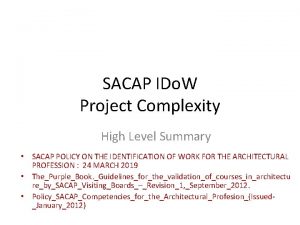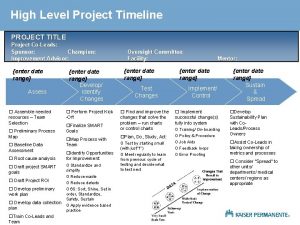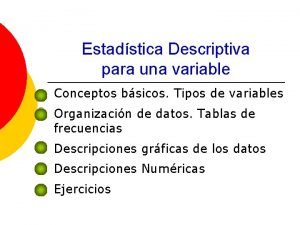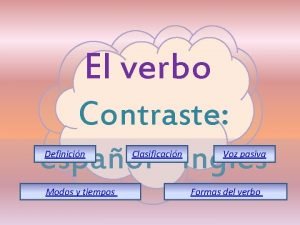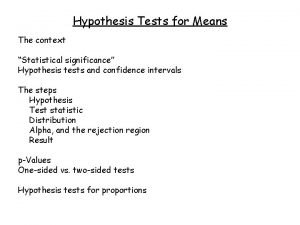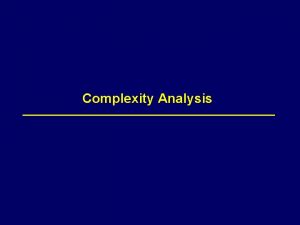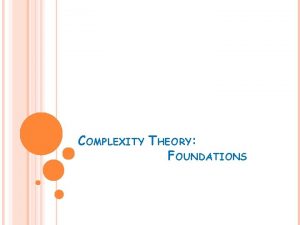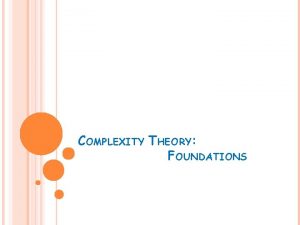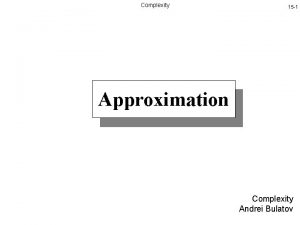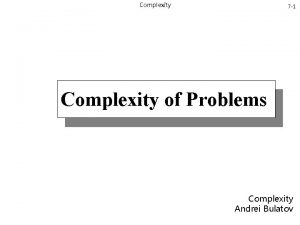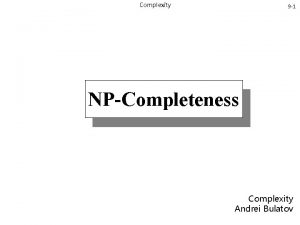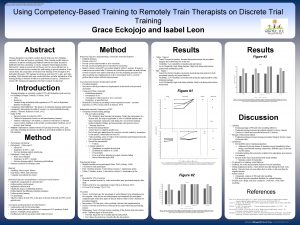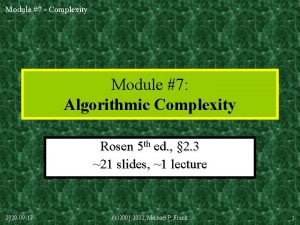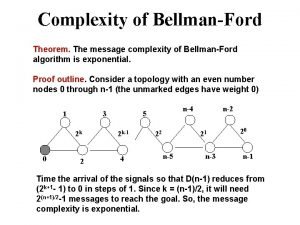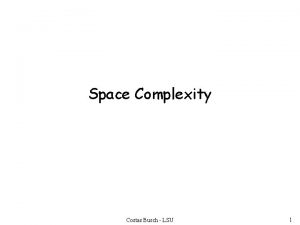SACAP IDo W Project Complexity High Level Summary










































- Slides: 42

SACAP IDo. W Project Complexity High Level Summary • SACAP POLICY ON THE IDENTIFICATION OF WORK FOR THE ARCHITECTURAL PROFESSION : 24 MARCH 2019 • The_Purple_Book. _Guidelines_for_the_validation_of_courses_in_architectu re_by_SACAP_Visiting_Boards_–_Revision_1, _September_2012. • Policy_SACAP_Competencies_for_the_Architectural_Profesion_(Issued_January_2012)

Introduction of Concept of Project Complexity High Level Summary

When was complexity determined for each category of Professional?

Project Complexity relating to Architectural Work Complexity was introduced in various forms: • As early as 2011: (Board Notice: 154 of 2011) – Complexity of the project – Square meterage – Site sensitivity

Project Complexity relating to Architectural Work The current IDo. W framework is entirely new: • It is not a revision of the previous framework as outlined in the Board Notice 154 of 2011 and the Interim SACAP IDOW Board Notice of 12 June 2013. • The fundamental difference is the interpretation of complexity which: – disregards square meterage and – relates to factors that determine the complexity of different building types - discussed later on…

Complexity Factors SACAP IDo. W High Level Summary

COMPLEXITY FACTORS Complexity Factors 1 2 3 4 5 6 Utility Structure Building Technologies Building Services Urban Context Occupational Health and Safety

Complexity Factors (1) 1. Utility • Refers to use and programme of a building. • Nature of the programme • Number of different uses within a building influences the complexity thereof. • Single use – singular use in response to a simple programme • Multiple use – generally more complex programmes • Mixed use – designed to accommodate a range of uses

Complexity Factors (2) 2. Structure • Single storey structures • Relates to support • conventional structures systems & elements of a • standard codes building - key design • ranging from simple to more informants, complex • Ensure that the building • Multiple storey structures can adequately withstand • more complex conventional both internal and structures external loadings • based on standard design • Forms the basis for detail codes design by Structural or • Non-conventional Civil Engineering structures Consultants. • derived from alternative technology systems & • subject to rational design.

Complexity Factors (3) 3. Building Technologies • refer to the various building systems (methods and materials) • that informs the complexity factors of • the building or installations • Conventional building technologies – Based on standards & codes. • Nonconventional building technologies – Are innovative and based on rational designs. • Indigenous technologies – Based on indigenous knowledge. • High–Technologies – Which includes specialised design, advanced methods of fabrication of materials…

Complexity Factors (4) 4. Building Services • their co-ordination are critical design informants • which must ensure optimal – – building performance and ensure safety, comfort and functionality. • the greater the number of services required, the higher the Complexity Rating. • Services • Mechanical, electrical, electronic, fire detection, alarm system, smart integration… • Energy efficiency • The Architectural Professional is responsible for the energy responsiveness • Bulk infrastructure • Investigation of existing bulk services and recommendation for new

Complexity Factors (5) 5. Urban Context Relates to the incorporation of • social, economic and • spatial design informants and • ensures buildings adequately responds/enriches their urban contexts. • Site sensitivity Design brief in collaboration with other specialist consultants including, inter alia, • urban designers • town planners • heritage and environmental consultants • Land use management • social impact, • cultural impact • heritage and environmental impact • compliance to local authority regulations or • restrictions in terms of land-use management and interventions required

Complexity Factors (6) 6. Occupational Health and Safety Relates to: • Design and specifications of the building and • Safety during construction Professionals MUST be aware of OHS Act Regulations wrt Designer… This forms the basis for • detail design and • co-ordination with other Professional Consultants and • contractors.

Introduction – Project Complexity Rating SACAP IDo. W High Level Summary

Project Complexity Rating PROJECT COMPLEXITY RATING PROJECT COMPLEXITY LEVEL A High complexity B Medium complexity C Low complexity DEFINITION As defined under “high complexity projects” As defined under “medium complexity projects” As defined under “low complexity projects”

Low complexity projects • Means simple buildings or groups of buildings in an • uncomplicated grouping • with low impact on its environs. • Structures with low performance requirements • Simple utilitarian character, design and detail • Constructed utilizing standard low technology building methods • Require minimum of mechanical and electrical services or equipment, and • Basic civil works infrastructure

Medium complexity projects • Means buildings or groups of buildings in a • relatively uncomplicated grouping • with medium impact on its environs. • Structures with medium performance requirements • Average character, design or detail • Require average level of mechanical and electrical services or equipment • Require non-complex structural and civil works

High complexity projects • Means building/s or groups of buildings in a • Large or complicated grouping • with significant impact on its environs. • Structures with high performance requirements • Sophisticated level of design or detail • Response to specialized requirements • Incorporates large or specialised mechanical, electrical & other specialist installations • Be of complex structural and civil works

Car Park Project Complexity CATEGORY BUILDING TYPES: OCCUPANCY HIGH MEDIUM LOW COMPLEXITY A CLASSIFICATION B C Commercial Surface car parks B 3 Commercial Multi-storey / underground car parks J 4

OVERVIEW Competencies And Skills Required To Perform Architectural Work High Level Summary

How is competency thereofe defined for each category of Professional?

Competencies And Skills Required To Perform Architectural Work There are two determining factors for assessment of competence: • academic training and • practice-based experience.

Competencies And Skills Required To Perform Architectural Work The 1 st frame of reference for such assessment is: • The National Qualifications Framework (NQF) levels as evident in the Higher Education Qualifications Sub Framework (HEQs. F) Professional Registration Category NQF Level of the relevant Professional Qualification Architect Master’s Degree - NQF 9 / B. Arch – NQF 8 Senior Architectural Technologist Honours Degree - NQF 8 / B Tech – NQF 7 Architectural Technologist Diploma – NQF 6 Architectural Draughtsperson Higher Certificate – NQF 5

Competencies And Skills Required To Perform Architectural Work The 2 nd frame of reference for such assessment is: • The 10 SACAP defined professional competencies Architectural design Environmental relationships Construction technology The structure of buildings Contextual & urban relationships Architectural history, theory & precedent Building services & related technologies Contract documentation and administration Computer applications Office practice, legal aspects and ethics 1 2 3 4 5 6 7 8 9 10

10 SACAP defined professional competencies The competencies must allow an architectural professional to compete and operate internationally. This required considerable benchmarking with competencies set out by other international validation agencies.

What is the terminology for describing the required level of learning/proficiency for each category of Professional?

10 SACAP defined professional competencies The terminologies used for describing learning/proficiency levels for the SACAP 10 Competencies are as follows: LEARNING LEVEL DESCRIPTION Awareness Acquaintance with relevant concepts and methods, without necessarily being skilled to paraphrase information. Knowledge Familiarity with relevant information, without necessarily being skilled to see its fullest implication or application. Understanding Full assimilation and comprehension of information, and the skill to correctly paraphrase it and relate it to other situations, including its practical application. Ability Skill in analysing problems, identifying appropriate information for the accomplishment of tasks and to apply it to the solution of specific problems.

What are some examples of competency for each category of Professional?

10 SACAP defined professional competencies We will look at 4 Competencies for illustrative purposes, to see the differences between the different categories of professionals: 1. Architectural Design 2. Environmental Relationships 3. Construction Technology 4. Building services & related technologies

SACAP professional competency 1 A person registered in one of the categories must demonstrate …

SACAP professional competency 2 A person registered in one of the categories must demonstrate …

SACAP professional competency 3 A person registered in one of the categories must demonstrate …

SACAP professional competency 4 A person registered in one of the categories must demonstrate …

How are the Education, Competencies and Complexity Factors for each category of Professional Aligned?

Alignment of Education, Competencies and Complexity Factors IDo. W 2018 – Professional competence rating Professional Registration Category NQF Level of the relevant Professional Qualification Requisite Rating (A, B or C) correlated to Complexity Factors according to the relevant Professional Competence Complexity Factors Diploma – NQF 6 Architectural Draughtsperson Higher Certificate – NQF 5 5 3 2 5 5 4 Environmental relationships Construction technology The structure of buildings Context and urban relationships Architectural history, theory and precedent Building services and related technologies 6. 7. 5. Architectural Technologist 4. Honours Degree - NQF 8 B Tech – NQF 7 3. Senior Architectural Technologist 2. Architect Master’s Degree - NQF 9 B. Arch – NQF 8 1. Architectural design 1 - 6 A B A A B A A B C C C B C The two determining factors for assessment of competence are: 1. 2. academic training and practice-based experience. The frames of reference for such assessment are the National Qualifications Framework (NQF) levels as evident in the Higher Education Qualifications Sub Framework (HEQs. F) and the 10 SACAP defined professional competencies respectively.

Competencies And Skills Required To Perform Architectural Work The relationship of the professionals’ • education, • competence, • the project complexity factors and • building type is shown in Schedule 1, Complexity Ratings of Building Types, in the IDo. W.

Sample of Project Complexity CATEGORY BUILDING TYPES: OCCUPANCY HIGH MEDIUM LOW COMPLEXITY A CLASSIFICATION B C Commercial Surface car parks B 3 Commercial Multi-storey / underground car parks J 4

Summary Project Complexity and Professional Competency: • A higher level of project complexity will require • A correspondingly greater level of professional competence.

Complexity and Competence Scenario – Car Parks x 2 SACAP IDo. W High Level Summary

Table Below illustrates the specific competencies of the various professionals based on their expertise as determined by their education / training / experience. A higher level of building complexity will correspondingly require a greater level of professional competence; an example from the IDo. W 2018 is reflected below: Building Type Project Complexity Surface car parks C - Low Multi-storey/underground car parks A – High Min. Prof. Competence Required C- Low A – High Min. Prof. Registered Category Required Professional Architectural Draughtsperson Professional Senior Architectural Technologist A denotes High B IDo. W 2018 – Professional competence rating denotes Medium C Professional Registration Category NQF Level of the relevant Professional Qualification Requisite Rating (A, B or C) correlated to Complexity Factors according to the relevant Professional Competence The Architectural Professional is therefore accountable for the project Complexity Factors as identified below: 1. Utility 2. Structure 3. Building Technologies 4. Building Services 5. Urban Context 6. Occupational Health and Safety 7. Existing buildings Complexity Factors 5 3 2 5 5 4 Environmental relationships Construction technology The structure of buildings Context and urban relationships Architectural history, theory and precedent Building services and related technologies Architectural design 1 - 6 denotes Low Higher Certificate – NQF 5 7. Architectural Draughtsperson 6. Diploma – NQF 6 5. Architectural Technologist 4. Honours Degree - NQF 8 B Tech – NQF 7 3. Senior Architectural Technologist 2. Architect Master’s Degree - NQF 9 B. Arch – NQF 8 1. The two determining factors for assessment of A B A A B A A B C C C B C competence are: 1. 2. academic training and practice-based experience. The frames of reference for such assessment are the National Qualifications Framework (NQF) levels as evident in the Higher Education Qualifications Sub Framework (HEQs. F) and the 10 SACAP defined professional competencies respectively.

Commercial Surface car parks Multi-storey / underground car parks B 3 7. 6. 5. 4. BUILDING TYPES: 3. CATEGORY 2. 1. J 4 C C C B A A A B B A Professional ARCHITECTURAL 2 DRAUGHTSPERSON C Professional ARCHITECTURAL TECHNOLOGIST C Pr Arch Professional SENIOR ARCHITECTURAL TECHNOLOGIST 4 5 5 2 3 5 1 - 6 Scope of Practice Matrix Professional ARCHITECT Building services and related technologies Architectural history, theory and precedent Context and urban relationships The structure of buildings Construction technology Environmental relationships Architectural design CLASSIFICATION OCCUPANCY IDo. W Alignment of Car Park Example IDENTIFICATION OF WORK PER PROFESSIONAL CATEGORY Requisite Rating (A, B or C) correlated to Complexity Factors according to the relevant Professional Competence Complexity Factors Professional Competence Pr. SAr ch. T Pr. Arc h. T Pr. Ar ch. D

SACAP IDo. W Project Complexity High Level Summary • SACAP POLICY ON THE IDENTIFICATION OF WORK FOR THE ARCHITECTURAL PROFESSION : 24 MARCH 2019 • The_Purple_Book. _Guidelines…Revision_1, _September_2012. • Policy_SACAP_Competencies_for_the_Architectural_Profesion_(Issued_January_2012)
 For loop space complexity
For loop space complexity Sacap compliance certificate
Sacap compliance certificate South african council for the architectural profession
South african council for the architectural profession Rcp hlsl
Rcp hlsl The lowest level of environmental complexity
The lowest level of environmental complexity High-level timeline
High-level timeline Nccd adjustment levels
Nccd adjustment levels Fio fis fit
Fio fis fit Ado edo ido
Ado edo ido Ido millet
Ido millet Dr totth lászló fül orr gégész kaposvár
Dr totth lászló fül orr gégész kaposvár Jezus hendrik-ido-ambacht
Jezus hendrik-ido-ambacht Conjugao
Conjugao En una clinica infantil se ha ido anotando
En una clinica infantil se ha ido anotando Ejemplos de voz activa
Ejemplos de voz activa Jezus hendrik-ido-ambacht
Jezus hendrik-ido-ambacht Nyugdíj szolgálati idő táblázat
Nyugdíj szolgálati idő táblázat Forma no personal del verbo participio
Forma no personal del verbo participio Delelési magasság kiszámítása
Delelési magasság kiszámítása Ido kanter
Ido kanter Fi-504010701/1
Fi-504010701/1 Mit jelent a kis erő nagy idő
Mit jelent a kis erő nagy idő Ido del sagrario tormento
Ido del sagrario tormento Ido tech
Ido tech Samurai ido
Samurai ido Ido recall
Ido recall Pontosid
Pontosid Pontos id[
Pontos id[ Molecular level vs cellular level
Molecular level vs cellular level Isis protocol
Isis protocol Dr shaffi
Dr shaffi Isis level 1 vs level 2
Isis level 1 vs level 2 What is the interpretation of a 96 confidence level
What is the interpretation of a 96 confidence level Confidence level and significance level
Confidence level and significance level Data flow diagram key
Data flow diagram key Security level 0
Security level 0 Costa question levels
Costa question levels Thread-level parallelism
Thread-level parallelism Night pfp
Night pfp Matlab high level language
Matlab high level language Lifted index
Lifted index Sql high level language
Sql high level language Form-based specifications
Form-based specifications

